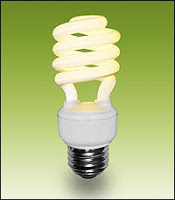I know this blog is supposed to be about what to feed your kids, but other issues keep on coming to my attention and I can’t resist blogging about them and getting the word out to other parents about the environmental dangers that seem to be everywhere.
Low voltage light bulbs were sold at my daughter’s school for a fundraiser but they didn’t work for us because we have dimmers all over our house and I like the look of regular light bulbs. I felt a little guilty about not buying into the energy efficient light bulb bandwagon, but for some reason I couldn’t make the switch.
Then a friend told me about the low voltage bulbs containing mercury and I was glad that I hadn’t made the change. Here is an excellent article on the issue
http://www.stumbleupon.com/demo/?review=1#url=http://www.msnbc.msn.com/id/23694819/
WHAT TO DO: Don’t buy compact fluorescent lightbulbs until the health issues and disposal issues are sorted out. If you don’t buy them, they will stop producing them and they won’t end up in our environment…and possibly in our drinking water.





Johnny 5 - As someone who sells light bulbs for a living, I am less enthusiastic than most about compact fluorescent bulbs. This is due to the fact that the ones currently available contain significant amounts of mercury. If one of these bulbs should break inside of a person’s home, it could cause a challenging disposal situation. It is my belief that the technology should progress to a point at which the mercury levels are low or nonexistent before people changeover their entire homes. Another consideration is that as these bulbs burn out, they will most likely be thrown away as though they are normal rubbish and landfills will have incredibly high levels of mercury in their soil as a result.
Krissy - Most CFLs today on the market contain less than 5mgs of mercury and there are CFL options out there that contain as little as 1.5mgs of mercury- which can hardly be called a “significant amounts of mercury” considering that many item in your home contain 100s of times more of mercury including your computer. Mercury levels in CFLs can never be “nonexistent” since mercury is a necessary component of a CFL and there is no other known element that is capable of replacing it. But CFLs actually prevent more mercury from entering the environment. According to the Union of Concerned Scientist, “a coal-fired power plant will emit about four times more mercury to keep an incandescent bulb glowing, compared with a CFL of the same light output”.